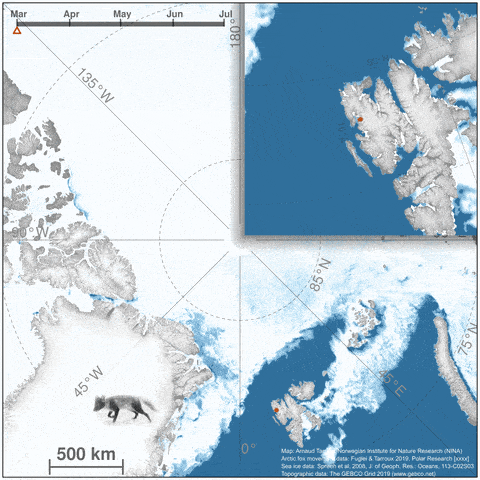
Arctic Fox’s Record-Breaking Journey Might Not Have Been Possible Without Sea Ice

A polar fox is fitted with a satellite tracking collar in Krossfjorden, Svalbard, a Norwegian Arctic archipelago, on July 29, 2017, as part of research conducted by the Norwegian Polar Institute. Norwegian researchers said July 2, that this young female arctic fox has been tracked walking from northern Norway to Canada's far north. Elise Stroemseng / Norwegian Polar Institute / Twitter
Scientists were left “speechless” by a female Arctic fox’s record-breaking journey from Norway’s Svalbard islands to northern Canada, BBC News reported Monday.
The fox traveled 3,506 kilometers (approximately 2,176 miles) in 76 days, one of the longest journeys for the species ever recorded, according to a paper documenting her trek. At one point, she clocked 155 kilometers (approximately 96 miles) a day.

Researchers made a gif of the fox’s travels across Greenland. She walked close to the North Pole for over 2,100 miles to Canada.
Norwegian Polar Institute
“This is the fastest movement rate recorded for this species,” Eva Fuglei from the Norwegian Polar Institute and Arnaud Tarroux from the Norwegian Institute for Nature Research wrote.
Fjellreven vandret via havisen fra #Svalbard i Europa til #Canada i Nord-Amerika i et tempo ingen forskere tidligere har dokumentert. Foto: Elise Stømseng Les mer: https://t.co/Gk3xirq3YE pic.twitter.com/adzOVNFfyx
— Norsk Polarinstitutt // Norwegian Polar Institute (@NorskPolar) June 26, 2019
But the climate crisis might deny future members of her species a chance to break her record. That’s because she reached that speed while traveling on the ice sheet in northern Greenland. The researchers speculated that her speed meant she was using sea ice as a “means of transport,” The Guardian reported.
“This is another example of how important sea ice is to wildlife in the Arctic,” Norway’s Minister of Climate and Environment Ola Elvestuen told the Norwegian Polar Institute, as The Guardian reported. “The warming in the north is frighteningly fast. We must cut emissions quickly to prevent the sea ice from disappearing all summer.”
Fuglei told The Guardian that this study was the first time they had documented a fox’s migration between Arctic continents and ecosystems.
The juvenile fox, who had been fitted with a tracking collar in 2017, began her journey on March 26, 2018 when she left Spitsbergen, the largest of the Svalbard Islands, NBC News reported. She surprised researchers by arriving in Greenland just three weeks later on April 16. She then traveled on to Canada’s Ellesmere Island. In total, she averaged 28.5 miles a day.
“We couldn’t believe our eyes at first. We thought perhaps it was dead, or had been carried there on a boat, but there were no boats in the area. We were quite thunderstruck,” Fuglei told Norway’s NRK public broadcaster, as BBC News reported.
The fox’s ultimate fate is not known, as the tracker stopped working in February.
Fuglei said the melting of the sea ice could have serious consequences for the Arctic fox.
“If the sea ice disappears, the arctic fox in Svalbard will become isolated,” Fuglei said, as NBC News reported.
But not all the consequences of global warming would be necessarily negative for the species.
“[H]igher temperatures could mean more Svalbard reindeer, and the foxes scavenge off their carcasses,” Fuglei told NRK, as BBC News reported.

 233k
233k  41k
41k  Subscribe
Subscribe 